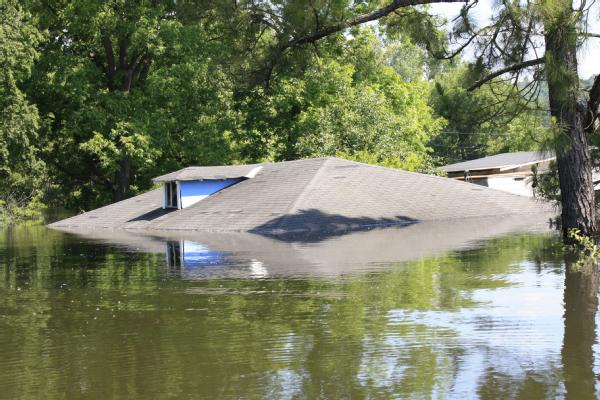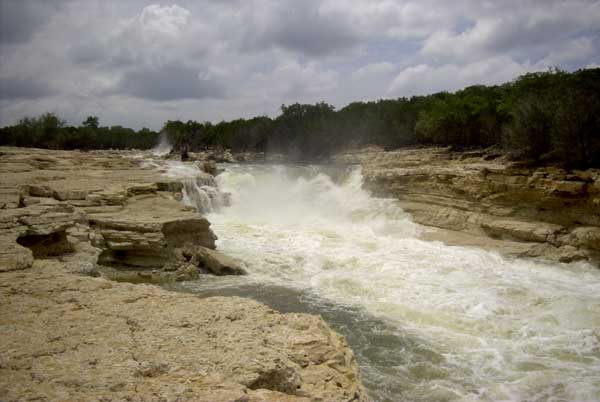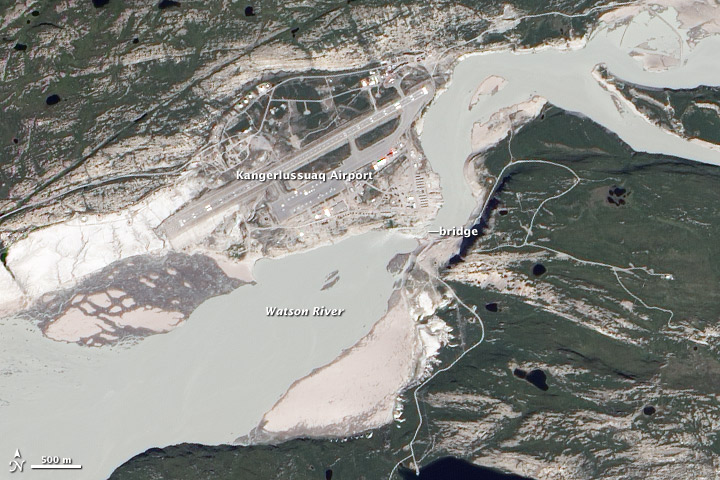Flood Facts, Types of Flooding, Floods in History
In terms of lives lost and property damaged, floods are just behind tornadoes as the top natural disaster. In the United States, flood damages totaled $8.41 billion in 2011. There were 113 flood-related deaths. Floods can affect any area to some degree; wherever rain falls, flooding can occur.
As water falls to the Earth in the form of rain or snow, it seeps into the ground. But if the ground is frozen or the surface impervious (asphalt or concrete are two contenders) or the soil is already saturated and cannot absorb the water faster than it falls from the sky, problems arise.
Water running downhill into channels and streams begins to "pile up", eventually overrunning the sides of those channels. How quickly this happens depends on the strength of the precipitation and the slope of the land. Sometimes flooding causes deep water to move quickly, while other times, shallow water may linger, taking days to dissipate.
Types of flooding
Overbank flooding:
What most people think of when they hear the word "flood." Filled to capacity because of heavy rain or melting snow, the water within a river overflows its banks and spreads across the land around it. Sometimes the area covered is wide and flat; water tends to spread out and be slow-moving, and may not appear to travel at all. Common in the Midwest, this kind of flooding can take days to dissipate. In mountainous areas, where water flows together through steep valleys, the flood water tends to move faster and linger for a shorter duration.
Flash floods:
Water from floods can take time to build up, allowing the population in an area time to be warned in advance. But sometimes flooding occurs quickly. Flash floods gather steam within six hours of the events that spawned them. They are characterized by a rapid rise of fast-moving water. Fast-moving water is extremely dangerous — water moving at 10 miles an hour can exert the same pressures as wind gusts of 270 mph (434 kph), according to a 2005 article in USA Today. Water moving at 9 feet per second (2.7 meters per second), a common speed for flash floods, can move rocks weighing almost a hundred pounds. Flash floods carry debris that elevate their potential to damage structures and injure people.
Get the world’s most fascinating discoveries delivered straight to your inbox.
Ice jam flooding:
In cold temperatures, bodies of water are often frozen. Heavy precipitation can cause chunks of ice to push together and create a dam in what is known as ice jam flooding. Behind the dam, water begins to pile up, spilling over to the plains nearby. Eventually, the wall of ice breaks, and fast-moving water rushes downstream much like a conventional flash flood, destroying objects in its path. The water carries huge chunks of ice, which can increase damage to surrounding structures.
Coastal flooding:
This type of flooding occurs along the edges of oceans, and is driven predominantly by storm surges and wave damage. This kind of flooding is usually connected to hurricanes, tsunamis or tropical storms. When low pressures occur in a storm over the ocean, they suck the water toward the center. As long as the eye is over deep water, problems are minimized, but as the storm moves toward land it carries a dome of water that can exceed 25 feet (7.6 meters) in diameter. When the dome reaches the shoreline, it can cause significant damage. At the same time, waves breaking along the shoreline assault beaches and structures, with destructive potential. In a hurricane, 9 out of 10 deaths are caused not by wind but by fast-moving storm surge.
Engineering issues
Flooding may be caused by manmade issues, as well. A weakly constructed dam could receive a more substantive battering than it was designed for and give way, creating a flash flood in the regions downstream.
In case of emergency
Fast- and slow-moving water can create significant problems for people who underestimate their power. According to the Environmental Protection Agency, attempting to drive through flood water is the leading cause of flood-related injury and death. Six inches of moving water can cause you to lose your balance and fall. The best plan is to avoid flood water when at all possible and to make for higher ground.
There are a number of things you can do to prepare for a flood and minimize damage.
- Structures should not be built in a flood plain.
- Keep your furnace, water heater, and electric panel elevated, especially if you live in an area where flooding is likely.
- Put together an emergency kit and make plans with your family — something that is ideal for any emergency situation, not just flooding.
- If you find yourself under a flood warning, make sure to pay attention to radio or television warnings.
- If you have time prior to an evacuation, turn off utilities at the main switches and disconnect electrical appliances.
- Move furniture and important items to higher levels in your house and bring in any outdoor furniture.
- Avoid contact with flood water. It may contain oil, gasoline, raw sewage, or any number of undesirable materials.
- Wash your hands thoroughly with clean water before eating, and do not drink from contaminated sources.
Damage from a flood depends on a number of things, including how long the water remains before receding and how quickly it was moving. Pay attention to roadways, which could have been weakened or washed out, and may be unsafe. Be careful entering buildings; fast-moving water could have weakened structural supports. If your home was submerged for an extended period, watch for signs of mold, which can cause illnesses.
Dangerous floods in history
The top five deadliest floods in world history occurred when the Huang He (Yellow) River in China exceeded its banks. The yellow silt that provoked the river's name can pile up higher than the land around it, causing the water to spill out of its causeway and onto the flat land surrounding it. Natural ice dams add to the problem. In an effort to control the damage, the Chinese government has built channels, dams and dikes to moderate the flow.
The deadliest flood came in 1931, when between 1 and 4 million people were killed. Thirty-four thousand square miles (88,000 sq km) of land were flooded, leaving 80 million people without homes. In 1887, natural flooding claimed between 1 and 2 million lives.
Strategic military flooding of the river top the third and fourth deadliest spots. In 1642, approximately 300,000 people died to flooding, famine, and plague when the Ming governor of Kaifeng ordered his men to break dikes along the river in an attempt to drown rebels assaulting his city. In 1938, the river was again used as a defensive weapon to halt the advance of invading Japanese troops, killing nearly a million people.
The worst dam collapse in history occurred in 1975, when significant rainfall following a typhoon assaulted the Banqiao dam on the Ru River in China. Almost 4 feet of rain poured down in a single day. A smaller dam upstream broke, sending a wall of water rushing downstream. A total of 62 dams failed in the incident, with walls of water between 10 and 20 feet high pouring onto the plains below. In an effort to control the flooding, some dams were deliberately destroyed with hopes of relieving some of the pressure. Approximately 230,000 people were killed.
Although China takes a frequent beating from flooding, the Netherlands also boast a number of deadly floods in its history. High tides and storms were responsible for the deaths of approximately 100,000 people in the Netherlands and England in 1099. A violent weather pattern known as a "Great Storm" created a storm tide in 1287 that broke a dike and killed up to 80,000 people. The same storm killed people in England. In 1421, the tenth deadliest flood in the world occurred when storms caused dikes to collapse. Water flowed across the lowlands, killing nearly 10,000.
The deadliest natural disaster in American history was the Hurricane of 1900 in Galveston, Texas. The Category 4 storm killed over 6,000 people, with most official reports citing closer to 8,000 dead. Storm surge killed many on trains attempting to evacuate the city. Floodwaters destroyed bridges and telegraph lines, keeping those outside of the city from realizing the extent of the damage for some time.
In fact, storm surge deaths caused by hurricanes dominate the list of flood dangers in the United States. These include the second most dangerous storm, the Okeechobee Hurricane in 1928, which caused over 2,500 deaths. In contrast, Hurricane Katrina claimed fewer than 2,000 lives.
Other dangerous incidents of flooding include a 1972 dam failure in Buffalo Creek, West Virginia. The dam, declared "satisfactory" only four days before the disaster, set off a chain reaction, as pressure from first broken dam caused a second to burst, and then a third. More than 132 million gallons of water were released, claiming 125 lives while injuring more than 1,100 people. Almost all 5,000 of the residents downstream were left homeless.
A 1976 flash flood in Colorado's Big Thompson Canyon after excessive rainfall created powerful water that ultimately killed 144 people and resulted in almost $40 million in damages. Waters reached speeds of more than 30 feet per second, moving 250-ton boulders with their powerful currants.
In the Great Flood of 1993, excessive rainfall in the Mississippi River basin caused significant flooding that did $20 billion in damages over a period of several months.
Floods and Climate
As the globe warms, flooding could become a more widespread problem. Warm air holds more moisture than cool air, so the heaviest precipitation events could become heavier as air temperatures tick upward. In 2015, Climate Central analyzed rain gauge records since 1950 and found that 40 out of the 48 states in the continental United States have seen increased heavy downpours over that time period. The Northeast now sees 31 percent more heavy downpours than it did in 1950. The Midwest sees 16 percent more.
Heavy downpours are defined as events where the precipitation dropped from the skies is more than the amount that accumulates from the top 1 percent of all rain and snow days over the study period. These bursts of precipitation — which usually fell as rain but sometimes as snow, the analysis found — are tough on infrastructure and can cause flooding. NOAA data also shows an increase in one-day precipitation events (single days of either rain or snow) since the middle of the 20th century. Climate models suggest that global flood risk will change as the world warms. One 2013 study in Nature Climate Change, for example, found large increases in the frequency of floods in eastern Africa, Southeast Asia, parts of India and parts of the Andes under climate change.
In glacial areas, climate change is likely to contribute to devastating floods more directly. Melting glaciers can put pressure on the natural dams that corral meltwater into the stunningly beautiful high-altitude lakes that dot places like the Himalayas and the Andes. When these dams fail, they can cause sudden and catastrophic outburst floods that send water ricocheting into narrow valleys below. In June 2016, researchers observed firsthand a glacial outburst flood at the Lhotse Glacier near Mount Everest that loosed about 4.8 million cubic miles (about 2 million cubic meters) of water from within the glacier itself. Fortunately, a village below the glacier was saved by stone walls that had been recently constructed, and nothing more was lost than a footbridge and one outbuilding.
Related:
- Better Prediction Sought for Devastating Floods
- Natural Disasters: Top 10 U.S. Threats
- What Are the Weirdest Floods Ever?
Further reading:
Editor's Note: This reference article was first published on Oct. 11, 2012; it was updated with information about climate change and floods on June 26, 2017.

Nola Taylor Tillman is a contributing writer for Live Science and Space.com. She loves all things space and astronomy-related, and enjoys the opportunity to learn more. She has a Bachelor’s degree in English and Astrophysics from Agnes Scott college and served as an intern at Sky & Telescope magazine. In her free time, she homeschools her four children.






